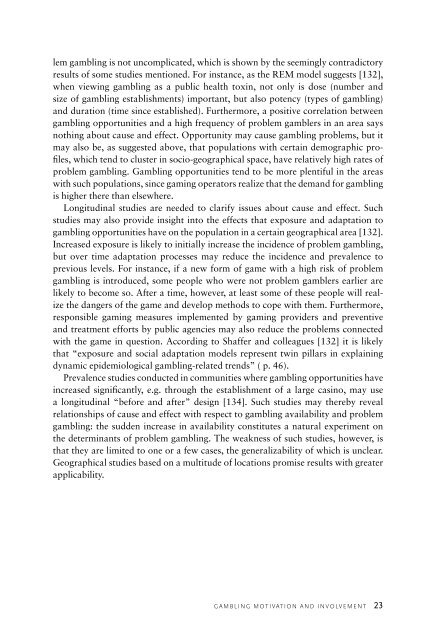Gambling motivation and involvement: A review of social
Gambling motivation and involvement: A review of social
Gambling motivation and involvement: A review of social
You also want an ePaper? Increase the reach of your titles
YUMPU automatically turns print PDFs into web optimized ePapers that Google loves.
lem gambling is not uncomplicated, which is shown by the seemingly contradictory<br />
results <strong>of</strong> some studies mentioned. For instance, as the REM model suggests [132],<br />
when viewing gambling as a public health toxin, not only is dose (number <strong>and</strong><br />
size <strong>of</strong> gambling establishments) important, but also potency (types <strong>of</strong> gambling)<br />
<strong>and</strong> duration (time since established). Furthermore, a positive correlation between<br />
gambling opportunities <strong>and</strong> a high frequency <strong>of</strong> problem gamblers in an area says<br />
nothing about cause <strong>and</strong> effect. Opportunity may cause gambling problems, but it<br />
may also be, as suggested above, that populations with certain demographic pr<strong>of</strong>iles,<br />
which tend to cluster in socio-geographical space, have relatively high rates <strong>of</strong><br />
problem gambling. <strong>Gambling</strong> opportunities tend to be more plentiful in the areas<br />
with such populations, since gaming operators realize that the dem<strong>and</strong> for gambling<br />
is higher there than elsewhere.<br />
Longitudinal studies are needed to clarify issues about cause <strong>and</strong> effect. Such<br />
studies may also provide insight into the effects that exposure <strong>and</strong> adaptation to<br />
gambling opportunities have on the population in a certain geographical area [132].<br />
Increased exposure is likely to initially increase the incidence <strong>of</strong> problem gambling,<br />
but over time adaptation processes may reduce the incidence <strong>and</strong> prevalence to<br />
previous levels. For instance, if a new form <strong>of</strong> game with a high risk <strong>of</strong> problem<br />
gambling is introduced, some people who were not problem gamblers earlier are<br />
likely to become so. After a time, however, at least some <strong>of</strong> these people will realize<br />
the dangers <strong>of</strong> the game <strong>and</strong> develop methods to cope with them. Furthermore,<br />
responsible gaming measures implemented by gaming providers <strong>and</strong> preventive<br />
<strong>and</strong> treatment efforts by public agencies may also reduce the problems connected<br />
with the game in question. According to Shaffer <strong>and</strong> colleagues [132] it is likely<br />
that “exposure <strong>and</strong> <strong>social</strong> adaptation models represent twin pillars in explaining<br />
dynamic epidemiological gambling-related trends” ( p. 46).<br />
Prevalence studies conducted in communities where gambling opportunities have<br />
increased significantly, e.g. through the establishment <strong>of</strong> a large casino, may use<br />
a longitudinal “before <strong>and</strong> after” design [134]. Such studies may thereby reveal<br />
relationships <strong>of</strong> cause <strong>and</strong> effect with respect to gambling availability <strong>and</strong> problem<br />
gambling: the sudden increase in availability constitutes a natural experiment on<br />
the determinants <strong>of</strong> problem gambling. The weakness <strong>of</strong> such studies, however, is<br />
that they are limited to one or a few cases, the generalizability <strong>of</strong> which is unclear.<br />
Geographical studies based on a multitude <strong>of</strong> locations promise results with greater<br />
applicability.<br />
G A M B L I N G M O T I VAT I O N A N D I N V O LV E M E N T 23

















